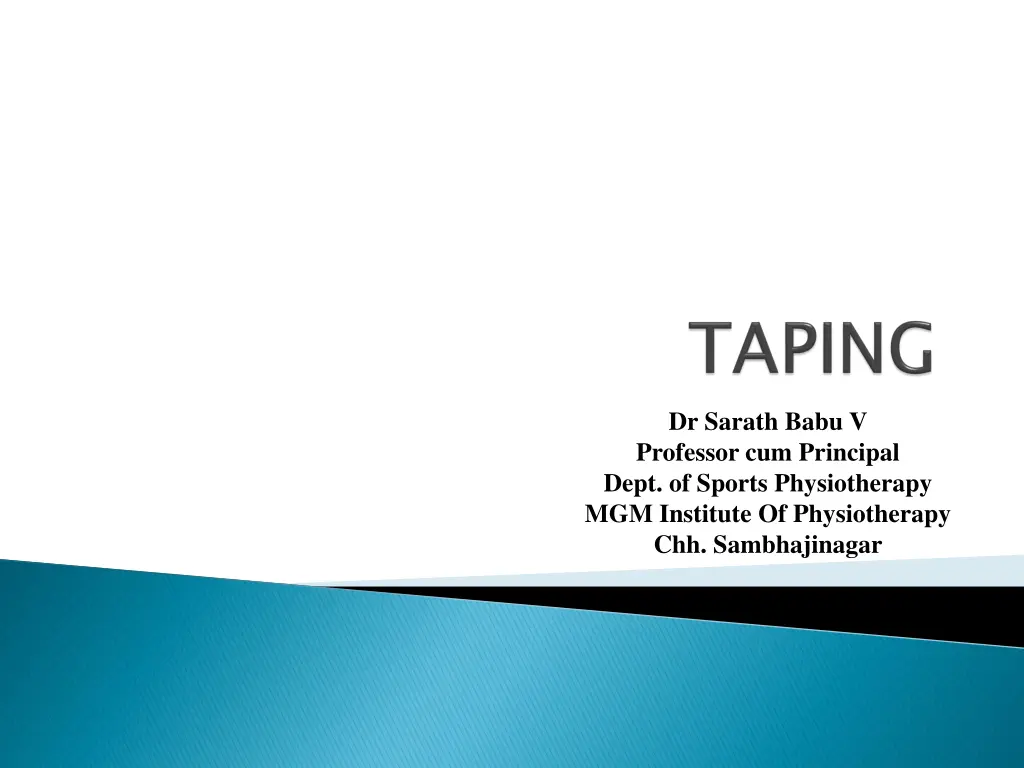
Benefits of Taping for Injury Recovery
Learn about the benefits and purposes of taping in sports physiotherapy, including enhanced healing, pain reduction, and early return to activity. Find out how correctly applied tape jobs can support injured structures, limit harmful motion, and aid in rehabilitation.
Download Presentation

Please find below an Image/Link to download the presentation.
The content on the website is provided AS IS for your information and personal use only. It may not be sold, licensed, or shared on other websites without obtaining consent from the author. If you encounter any issues during the download, it is possible that the publisher has removed the file from their server.
You are allowed to download the files provided on this website for personal or commercial use, subject to the condition that they are used lawfully. All files are the property of their respective owners.
The content on the website is provided AS IS for your information and personal use only. It may not be sold, licensed, or shared on other websites without obtaining consent from the author.
E N D
Presentation Transcript
Dr Sarath Babu V Professor cum Principal Dept. of Sports Physiotherapy MGM Institute Of Physiotherapy Chh. Sambhajinagar
The rationale for taping is to provide protection and support for an injured part while permitting optimal functional movement. An essential rehabilitation tool, taping enhances healing by allowing early activity within carefully controlled ranges that can facilitate a faster recovery from injury.
Taping also permits an earlier return to activity, play or competition by protecting the area from further injury or exacerbation of the existing injury and avoiding compensatory injuries elsewhere such as delayed hip muscle activation, as can happen with severe ankle injuries. Taping also reduces pain.
The purposes and benefits of correctly applied tape jobs are delineated as follows. Purposes Supports an injured structure Limits harmful ranges of motion Enhances repair and recovery Allows pain-free functional movement Permits protected resumption of activities Decreases pain Purposes
Benefits Circulation is enhanced through pain-free movement Swelling is controlled Prevents: worsening of initial injury compensatory injury to adjacent parts atrophy from non-use Benefits Prevents:
open wounds scars which have not yet healed Acute episodes of neurodermatitis or psoriasis known allergies to acrylic Prior to all applications, the therapist should first ask whether the patient is taking anticoagulants. Small reaction to the lifting effect of the K-Taping application. anticoagulants. Small hemorrhages hemorrhages may occur in the skin as a
Sports tape is designed to stay on for the duration of the sport and then it should be removed. Care must be taken when taping, especially when encircling an area of the body as the blood and nerve supplies can be compromised
The adhesion of the K-Tape to the skin, and the resulting mechanical displacement caused by body movement, leads to stimulation of the mechanoreceptors in the skin. Like the nociceptive afferents, these proprioceptive afferents also run to the dorsal horn and inhibit the relaying of nociception.
Bracing No expertise needed; can be applied by the patient Reusable Non-allergenic Adjustable Cost-effective Certain braces may be banned from some sports
Taping Individually applied Less bulky than a brace Caters for unusual anatomy Some expertise needed to apply Acceptable form of support in all sports
The choice of taping technique requires specific knowledge and observation skills. The following points are essential to ensure an effective, efficient taping application: a thorough knowledge of the anatomy of the area to be taped evaluation skills to assess: a. structure(s) injured b. degree of injury c. stage of healing appropriate tape and choice of technique consideration of sport-specific needs (if applicable).
be prepared to adapt your technique to suit individual needs adequate preparation of the area to be taped effective application of tape testing on completion of taping
Always explain the reasons for taping to the patient so that they are fully informed of why you are recommending tape and they can give their consent to be taped. Always enquire if they have experienced allergic reactions to tape. A simple question is usually sufficient, such as Is your skin irritated by wearing a Band- Aid? . If in doubt, you may apply a small test patch of tape to the skin as a method of assessment.
If the patient does have known allergic reactions or develops one, try underwrap or hypoallergenic tapes or skin balms. Should the patient feel any irritation from the tape at any time, it should be removed immediately and the skin washed and cleaned. Should the patient feel any irritation from the tape at any time, it should be removed immediately and the skin washed and cleaned.
SWELLING UNDUE STRESS PROTECTION PAIN and discomfort OPTIMAL ( REHABILITATION THERAPEUTIC CARE SWELLING UNDUE STRESS PROTECTION PAIN and discomfort OPTIMAL (healing and tissue repair ) ) REHABILITATION THERAPEUTIC CARE
SWELLING padding and/or compression to prevent irritating exudates and other fluids from accumulating (oedema) and to ensure the best environment for tissue regeneration and repair. UNDUE STRESS prevented so as to reduce the possibility of additional injury or of increasing the severity of the injury. SWELLING must be controlled by adequate UNDUE STRESS to the injured region must be
PROTECTION tissue damage (i.e. bruises, blisters, tape cuts) by using pads, lubricants and other protective materials. . PAIN and discomfort supporting the injured part, by controlling unnecessary or excessive movement, and by taking care not to cause further irritation to the injured tissues. PROTECTION of the area from further soft PAIN and discomfort must be minimized by
OPTIMAL enhanced through correctly applying tape, keeping the range of motion within safe limits and maintaining continuous compression. REHABILITATION functional state (joint mobility, soft tissue flexibility, muscle strength, ligament stability, neuromotor control and proprioception) must be considered when choosing the right taping technique adaptation for the appropriate stage of rehabilitation (subacute, functional, return to sport). OPTIMAL healing and tissue repair can be REHABILITATION of the tissues to a fully
THERAPEUTIC CARE treatment is critical for a rapid recovery. Treatment may include the application of electrical modalities (ultrasound, laser, interferential electrotherapy, muscle stimulation, etc.), manual treatment and exercise therapy to control pain and swelling and to promote rapid healing. THERAPEUTIC CARE in the early stages of
In addition to being aware of the purposes of a particular taping application, there are conditions or situations to observe or to avoid after the taping is completed. The mnemonic P P. R. E. C. A. U. T. I. O. N help you recall several important points after taping. . R. E. C. A. U. T. I. O. N. will
PRE MATURE involves the injured part must be avoided. A major mistake many patients, especially athletes, make is returning to action too soon. This can delay healing and often results in reinjury to the weakened structures as well as increasing the chance of further complications to the compensatory areas. PRE MATURE participation in an activity which
RANGE OF MOTION maintained as close as possible to normal for the body part involved. Severe limitation of motion can result in an overextension of surrounding or compensatory structures, prolong repair and recovery and lead to tissue changes in and around the joint injured. Permitting too free a range of motion will not adequately protect the tissues involved and can leave them prone to further injury. RANGE OF MOTION should be restricted but
EXPERT serious injury, particularly a fracture, dislocation or tissue rupture, is suspected. Also, a paying agency or government regulation may require a physician s assessment prior to treatment. EXPERT opinion must be obtained when any
CIRCULA TION monitored for any sign of constriction. Pressure bandages must be checked regularly. ALLERGIES AND SKIN IRRITATIONS real problem, one that is frustrating for both the patient and the taper. The more serious degree of allergic reaction results in localized blistering, welts, pustules, rashes and pain. Simple irritation is generally a less severe reaction of reddened skin or small blisters. CIRCULA TION in the injured area must be ALLERGIES AND SKIN IRRITATIONS present a very
UNDUE DEPENDENCY ON TAPING psychological danger which may arise when patients, especially athletes, think that they cannot perform without taping. In such cases the injured area may not return to its preinjury performance level. Associated with prolonged immobility, this situation may lead to the patient spending unnecessary time having manual therapy to overcome the results of excessive or prolonged taping. UNDUE DEPENDENCY ON TAPING is a
TENDONS, MUSCLES AND BODY PROMINENCES care and attention so as to avoid pressure build-up and friction. TENDONS, MUSCLES AND BODY PROMINENCES must be treated with special
ICE that is to be immediately subjected to taping. The temporary reduction of tissue volume due to icing will result in a taping that will tighten progressively as the body part warms up. Also, patients may have reduced skin sensation after icing, and tissue injury can result from such sensory loss. ICE should not be applied to an injured part
ONLY order to ensure a consistently high standard of tape application. NERVE conduction and local sensation affected by secondary inflammation or by the taping job itself. It is essential to evaluate the level of sensation prior to taping so that factors altering sensation can be assessed properly. ONLY top-quality supplies should be used in NERVE conduction and local sensation may be






















